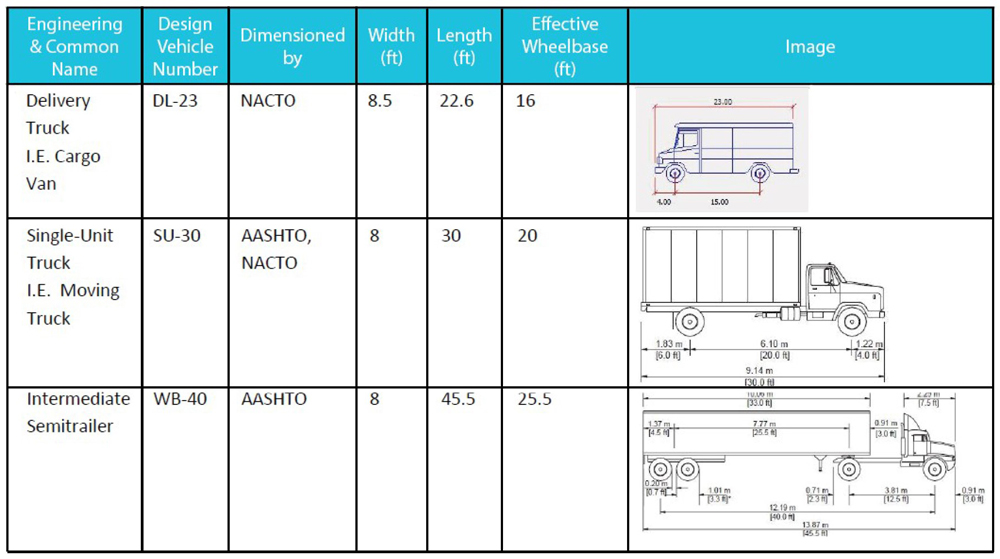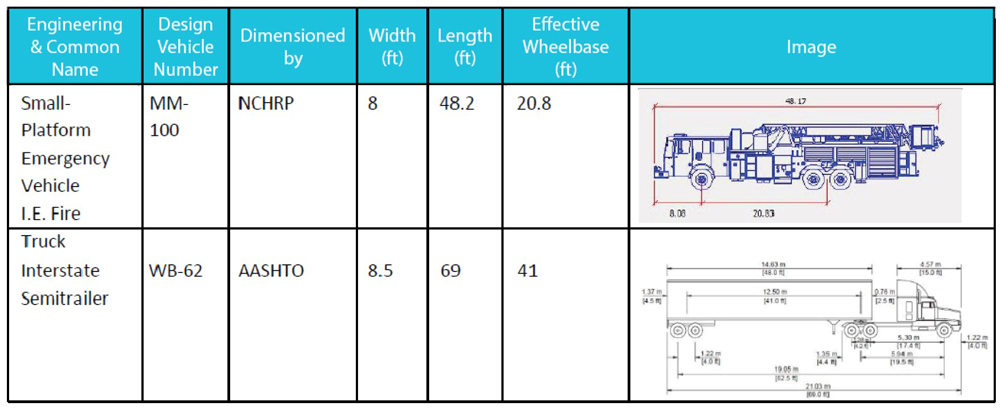3.7B Design and control vehicles
Search Content
Download PDF
Print Guide
Introduction
Intersection design must prioritize safety for the most vulnerable users of the roadway while accommodating safe movement for the appropriate mix of motorized vehicle types. This balance is achieved through utilizing the following design principles:
- Incorporating the smallest practical curb-return radius to reduce driver turning speeds while still accommodating ADA-compliant pedestrian facilities;
- Reducing the intersection crossing distance as much as possible for people walking and biking while improving sightlines for drivers; and
- Design intersections for the appropriate mix of motorized traffic by selecting the appropriate design and control vehicles.
In the design process, the design and control vehicles are important determinants for curb-return radii. Selection of an appropriately sized vehicle is a critical aspect of achieving streets that prioritize safety for the most vulnerable users of the roadway. When a street is designed to accommodate design and control vehicles larger than typically necessary, the safety of people walking, biking, and driving is negatively impacted by intersections that promote higher turning speeds and longer crossing distances. Selecting design and control vehicles smaller than appropriate also compromises the safety of people biking and walking, as large vehicles may be required to frequently mount the curb to complete a turn.
Design Vehicle
The design vehicle is the least maneuverable vehicle expected to regularly use the intersection; it informs what vehicular operations need to be accommodated regularly in the geometric design of the intersection. Design vehicles should typically be accommodated without encroachment into opposing traffic lanes.
The smallest appropriate design vehicle should be selected based upon the street type and adjacent land use context. Depending on the street typology, Minneapolis uses the following typical design vehicles: DL-23, SU-30, and WB-40. See Figure 3.7B.1 and Figure 3.7B.2.
Exceptions
Using different design vehicles than prescribed in Figure 3.7B.2 may be pursued in the following circumstances:
- When there is a demonstrated need to routinely accommodate turning design vehicles larger than prescribed in Figure 3.7B.2 (e.g. a city bus, WB-40, or WB-50)).
- Project managers must demonstrate the need to accommodate design vehicles larger than prescribed in Figure 3.7B.2 through the following process:
- Collect traffic data to determine the mix of heavy vehicle traffic;
- Work with property owners to identify specific vehicles, confirm access points, and delivery times and frequencies; and
- Determine if existing and future needs necessitate accommodating a larger design vehicle.
- Project managers must demonstrate the need to accommodate design vehicles larger than prescribed in Figure 3.7B.2 through the following process:
- At intersections with bus routes where transit buses are routinely required to make a turn, an appropriately sized bus may be used as the design vehicle.
- Project managers must accommodate necessary turning movements for transit service and should anticipate any future routing revisions during the design process.
- Along bus routes where buses are not required to turn, design vehicles smaller than a bus may be used.
Control Vehicle
The control vehicle is an infrequent but necessary user of the street and informs what vehicular operations need to be accommodated somehow in the design of the street.
- Current Traffic and Parking Services policy allows control vehicles to encroach into approximately 1/3rd of adjacent or opposing travel lanes or into the gutter pan.
-
For Urban Neighborhood streets, Parkways, and streets without a striped centerline, control vehicles may generally use the full curb-to-curb width to complete their turns.
-
Infrequent vehicles larger than the control vehicle can still navigate the intersection, but would need to encroach beyond 1/3rd of adjacent or opposing travel lane and/or track over the curb to make the turn.
-
- See Figure 3.7B.3 for control vehicle examples and Figure 3.7B.4 for typical control vehicles by intersecting street type.
- Emergency vehicles always need to be accommodated, regardless of street type. Therefore, a fire truck (Aerial Fire Truck MM 100) is the identified Minneapolis control vehicle for most street types with low volumes of heavy vehicle traffic. The Aerial Fire Truck will accommodate turning movements for all vehicles including and smaller than a WB-40. Project managers should continue to work with the Minneapolis Fire Department to understand evolving vehicle designs and operations.
- For truck routes, Production and Processing streets, and Mixed Use Regional Connectors where higher volumes of heavy vehicle traffic is expected, a WB-62 semi-trailer truck should typically be used as the control vehicle.
Figure 3.7B.4:
Typical Control Vehicles by Intersecting Street Type
- FIRE assumes an "Aerial Fire Truck Mid Mount (MM) 100." An Aerial Fire MM 100 will accommodate turning movements for all vehicles including and smaller than a WB-40.
- Project managers should confirm whether WB-62 turning movements need to be accommodated at all intersections during the design process.
- For Urban Neighborhood streets, Parkways, and streets without a striped centerline, control vehicles generally may use the full curb-to-curb width to complete their turns.
Exceptions
Using different control vehicles than prescribed in Figure 3.7B.4 may be pursued in the following circumstances:
- On intersecting streets where WB-62 is identified as the typical control vehicle, a smaller vehicle should be used where WB-62 turning movements are not anticipated or expected in the future.
- When there is a demonstrated need to routinely accommodate turning control vehicles larger than prescribed in Figure 3.7B.4 (e.g. a WB-50, WB-62, and on rare occasions a WB-67). Project managers must demonstrate the need to accommodate control vehicles larger than prescribed in Figure 3.7B.4 through the following process:
- Collect traffic data to determine the mix of heavy vehicle traffic;
- Work with property owners to identify specific vehicles, confirm access points, and delivery times and frequencies; and
- Determine if existing and future needs necessitate accommodating a larger control vehicle.
Considerations for County and MnDOT Roads
- County and MnDOT Roads. City staff should encourage design and control vehicles in line with the guidance in this section when coordinating with Hennepin County and MnDOT staff on intersections with County and MnDOT roads.
- Hennepin County. When determining design and control vehicles, Hennepin County considers the context of the intersection, the mix of vehicles making turns, and coordinates with the local jurisdiction.
- For design vehicle, County staff frequently use the WB-50.
- For control vehicles, County staff typically uses a WB-62 on CSAH (County State Aid Highway) to CSAH routes, and a WB-50 on CSAH to MSA (Municipal State Aid) routes.
- MnDOT. The MnDOT Road Design Manual calls for the largest frequent user to be design vehicle and states that that typically is the WB-62. However, the manual offers the following direction to the designer when choosing the design vehicle:
- Passenger Car (P)- when the main traffic generator is a parking lot or a series of parking lots. *equivalent direction provided in AASHTO Green Book
- Single Unit Truck (SU) - at intersections with park roadways and residential streets. *equivalent direction provided in AASHTO Green Book
- BUS - at city streets which carry bus routes but have very few trucks and at park and ride facilities.
- *equivalent direction provided in AASHTO Green Book
- (WB-62) truck - at intersections with other trunk highways, high volume CSAHs and County Roads, and highly industrialized streets.







